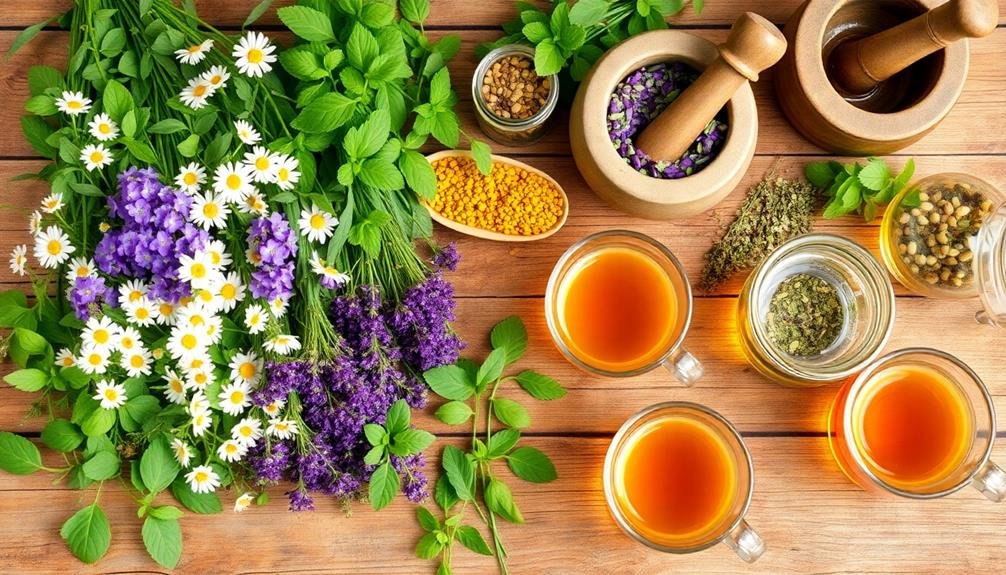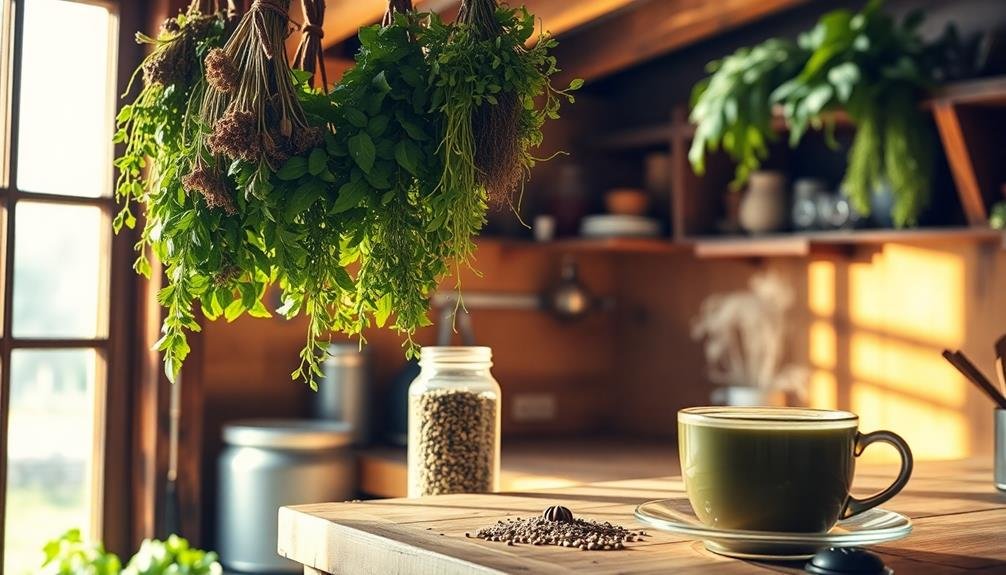Air-drying herbs is a fantastic way to create your own flavorful infusions for homemade tea. This method preserves essential oils and nutrients, maximizing the taste and health benefits of your herbs. Start by gathering fresh, healthy leaves and rinse them gently. Hang them upside down in a cool, dark space, or lay them flat to dry. Once dried, store your herbs in airtight containers to keep their potency. You can mix and match different herbs, like chamomile or hibiscus, to craft a blend that suits your taste. Discover the details on which herbs to choose and how to brew the perfect cup.
Benefits of Air-Drying Herbs

When you air-dry herbs, you're not just preserving their flavor; you're also revealing a host of benefits that enhance your homemade tea. First, air-drying allows the herbs to maintain their essential oils and nutrients, which can boost the health benefits of your tea. These oils are responsible for the rich flavors and aromas you love, so drying them properly guarantees you get the most out of each infusion.
Moreover, air-drying is an energy-efficient method, requiring no electricity or special equipment. You can simply hang your herbs in a well-ventilated area, letting nature do the work for you. This process also minimizes the risk of mold and retains the herbs' natural colors, giving you a visually appealing addition to your tea collection.
Additionally, air-drying extends the shelf life of your herbs, allowing you to enjoy their flavors long after the growing season ends. You'll save money and reduce waste, as you can harvest and store your herbs at their peak freshness.
Best Herbs for Tea
When it comes to making the perfect cup of tea, knowing the best herbs to use can elevate your experience.
Each herb brings its unique flavor profile and health benefits, making your homemade tea not only delicious but also nourishing.
Let's explore some popular tea herbs that you can easily grow and air-dry for your next brewing adventure.
Popular Tea Herbs
While many herbs can enhance your tea experience, some stand out due to their unique flavors and health benefits. By incorporating these popular tea herbs into your collection, you can create delightful blends that not only taste great but also provide various wellness advantages.
- Peppermint: This invigorating herb is perfect for soothing digestion and providing a cooling sensation. It's a favorite for those looking to invigorate their tea time.
- Chamomile: Ideal for relaxation, chamomile offers a gentle, floral flavor that can help reduce stress and promote sleep. It's a go-to herb for winding down after a long day.
- Lemon Balm: With its lemony aroma, lemon balm adds a bright note to teas. It's known for its calming effects and can aid in alleviating anxiety.
- Hibiscus: This vibrant, tart flower creates a beautiful red tea that's rich in antioxidants. Hibiscus tea is rejuvenating and can help support heart health.
Experimenting with these herbs will elevate your homemade tea, making each cup a delightful experience that caters to your taste and wellness needs.
Herbal Flavor Profiles
Understanding herbal flavor profiles can greatly enhance your tea-making experience. When you select the right herbs, you'll create infusions that cater to your taste preferences.
Start with chamomile—its sweet, floral notes are calming and perfect for evening relaxation. If you enjoy a more robust flavor, consider using peppermint. Its revitalizing, minty taste can invigorate your senses and aid digestion. For a unique twist, try lemongrass, which adds a citrusy zing that brightens your tea.
Brew a blend of lavender and lemon balm for a soothing herbal mix that offers floral and lemony undertones. If you prefer something earthier, go for sage or thyme; their savory profiles provide depth and complexity.
Don't overlook the versatility of hibiscus, which lends a tart and fruity flavor, ideal for iced teas. For a touch of sweetness, fennel seeds can introduce a mild anise-like taste that balances well with stronger herbs.
Experiment with combinations to discover your perfect blend. By understanding these herbal flavor profiles, you'll create delicious, personalized teas that are sure to impress.
Health Benefits Overview
Brewing your own herbal tea not only delights the senses but also offers a range of health benefits. Choosing the right herbs can enhance your well-being in several ways.
Here are some of the best herbs for tea and their health benefits:
- Peppermint: This herb promotes digestion and can relieve headaches. Its invigorating flavor keeps you energized throughout the day.
- Chamomile: Known for its calming properties, chamomile tea can help you unwind and improve sleep quality, making it perfect for evening relaxation.
- Ginger: A powerhouse of anti-inflammatory properties, ginger tea can help alleviate nausea and boost your immune system. Plus, it adds a zesty kick to your brews!
- Hibiscus: Rich in antioxidants, hibiscus tea can support heart health and may help lower blood pressure. Its tart flavor makes it a delightful addition to any tea collection.
Step-by-Step Drying Process

To dry your herbs effectively, start by gathering fresh, healthy leaves from your chosen plants. Look for vibrant, unblemished leaves and avoid any that show signs of disease or wilting.
Once you've collected your herbs, rinse them gently under cool water to remove any dirt or pests. Pat them dry with a clean towel, ensuring they're not too damp.
Next, bundle your herbs into small groups, securing them with string or rubber bands. Hang these bundles upside down in a cool, dark, and well-ventilated area, like a pantry or closet. The key is to maintain airflow to prevent mold.
Alternatively, you can lay the leaves flat on a drying rack or a clean screen, spreading them out evenly.
Check your herbs daily for dryness. Depending on the type of herb and humidity levels, this could take anywhere from a few days to a couple of weeks. You'll know they're ready when the leaves crumble easily between your fingers.
Once dried, you can proceed to the next steps for preparing your homemade tea, ensuring you've captured the essence of your herbs perfectly.
Proper Storage Techniques
Proper storage is essential to maintaining the flavor and potency of your dried herbs. To guarantee your herbal treasures stay fresh, follow these simple techniques:
- Use Airtight Containers: Store your herbs in airtight glass jars or food-safe containers. This helps prevent moisture and air from degrading their quality.
- Keep Them Cool and Dark: Place your containers in a dark, cool place, like a pantry or cupboard. Sunlight and heat can cause herbs to lose their vibrant flavors over time.
- Label and Date: Always label your containers with the herb's name and the date you dried them. This way, you'll easily keep track of their freshness and know when they're best used.
- Avoid Frequent Opening: Limit how often you open the containers. Each time you expose your herbs to air, they become more susceptible to losing their potency.
Crafting Your Herbal Blend

Creating your own herbal blend can be a rewarding experience that allows you to tailor flavors and health benefits to your liking. Start by choosing the herbs you want to use. Consider popular options like chamomile for relaxation, peppermint for digestion, or lemon balm for stress relief. Each herb brings unique properties, so think about what you want to achieve with your blend.
Once you've picked your herbs, experiment with ratios. A good rule of thumb is to start with a base of one or two dominant herbs and then add complementary flavors. For example, mixing lavender with chamomile can create a soothing blend, while ginger and turmeric offer a warming, spicy kick.
Don't forget to include a few aromatic herbs to enhance the scent and flavor. A touch of rosemary or basil can elevate your infusion.
As you blend, keep tasting and adjusting until you find the perfect balance.
Brewing Perfect Infusions
Once you've crafted your herbal blend, the next step is brewing the perfect infusion to release those flavors and benefits. Here's how to guarantee you get the most out of your dried herbs:
- Choose the Right Water Temperature: Different herbs require different water temperatures. For delicate herbs like chamomile, use water just below boiling, while sturdier herbs like rosemary can handle boiling water.
- Use Fresh Water: Always start with fresh, cold water. Avoid using previously boiled water, as it can impact the taste and potency of your infusion.
- Measure the Herbs: A general guideline is to use one teaspoon of dried herbs per cup of water. Adjust according to your taste—experiment to find your perfect balance.
- Steep for the Right Time: Let your herbs steep for about 5-10 minutes. Steeping too long can lead to bitterness, while not steeping long enough might leave you with a weak infusion.
Frequently Asked Questions
How Long Do Dried Herbs Last Before Losing Flavor?
Dried herbs typically last about one to three years before they start losing flavor. To keep them fresh longer, store them in airtight containers away from light, heat, and moisture. Check for aroma regularly.
Can I Air-Dry Herbs in Humid Climates?
You can air-dry herbs in humid climates, but it might take longer. Guarantee good airflow and consider using a dehydrator if conditions are too damp to prevent mold and preserve flavor effectively.
Is It Safe to Dry Herbs in Sunlight?
Yes, it's safe to dry herbs in sunlight, but be cautious. Direct sunlight can cause flavor loss and color fading. Instead, consider a shaded spot or use a dehydrator for better results.
What Equipment Do I Need for Air-Drying Herbs?
To air-dry herbs, you'll need a clean, breathable container like a basket or mesh bag, scissors for cutting, and a cool, dark space with good air circulation. It's essential for preserving flavor and quality.
Can I Mix Different Herbs for Drying Together?
Yes, you can mix different herbs for drying together! Just make sure they have similar drying times and flavors that complement each other. Experimenting will help you discover unique blends you'll love in your teas.
In Summary
Air-drying herbs is a simple and rewarding way to enjoy homemade tea. Not only do you get to select your favorite herbs, but you also create unique blends that suit your taste. By following the drying process and storage techniques, you'll guarantee your herbs retain their flavor and potency. So go ahead, gather your herbs, experiment with different combinations, and brew your perfect infusion. You'll savor every sip knowing you crafted it yourself!





Leave a Reply